2022届高三英语二轮复习定语从句课件(51张ppt)
文档属性
| 名称 | 2022届高三英语二轮复习定语从句课件(51张ppt) | 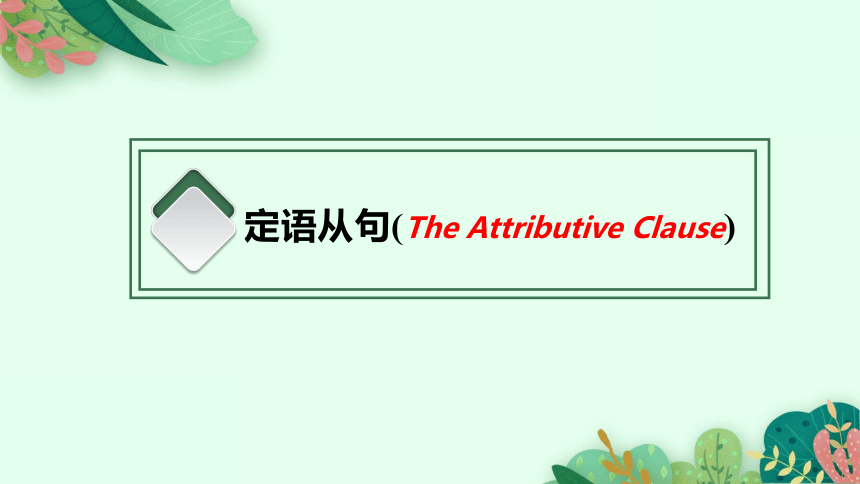 | |
| 格式 | zip | ||
| 文件大小 | 1.1MB | ||
| 资源类型 | 教案 | ||
| 版本资源 | 通用版 | ||
| 科目 | 英语 | ||
| 更新时间 | 2022-05-17 16:09:16 | ||
图片预览

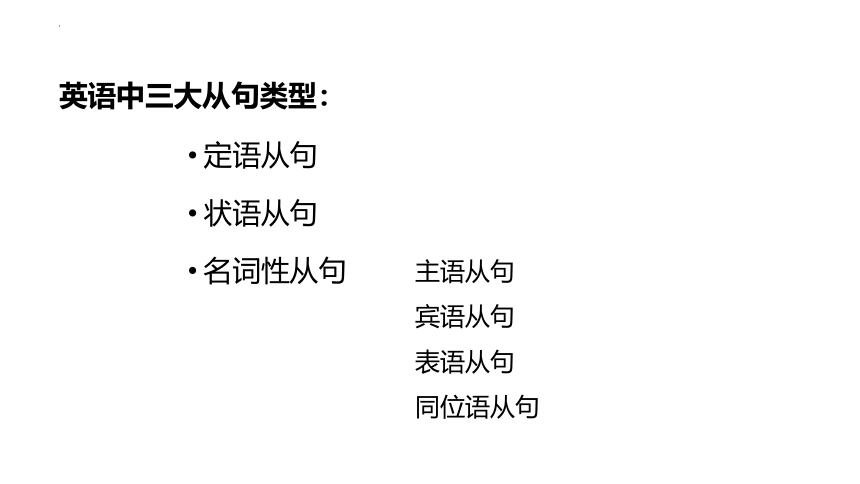
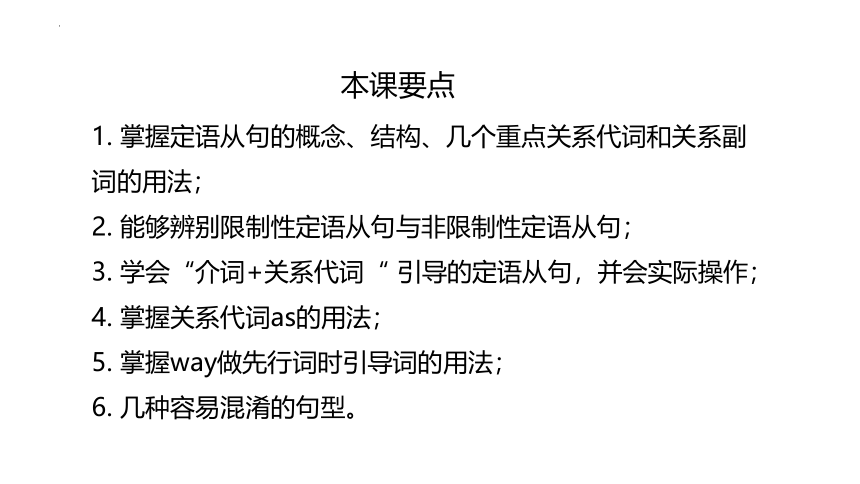
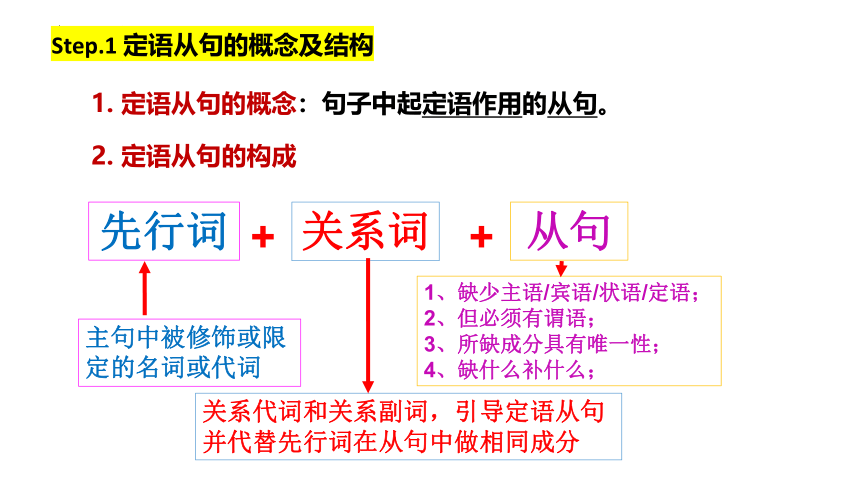
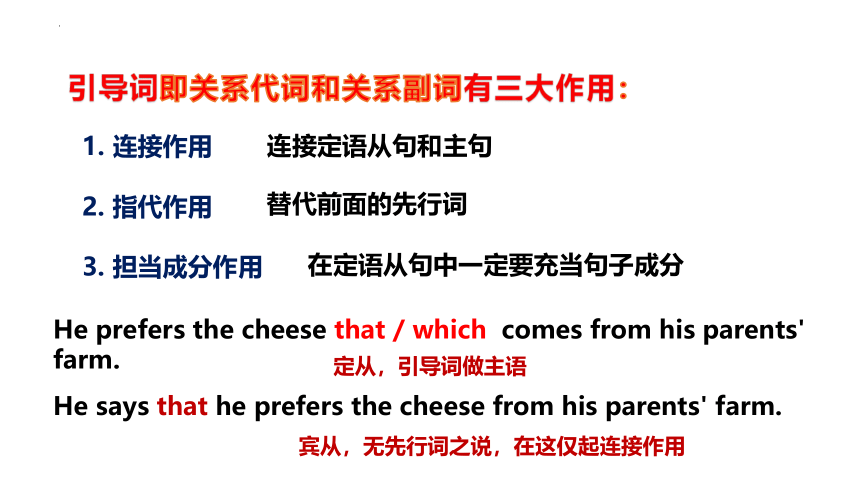
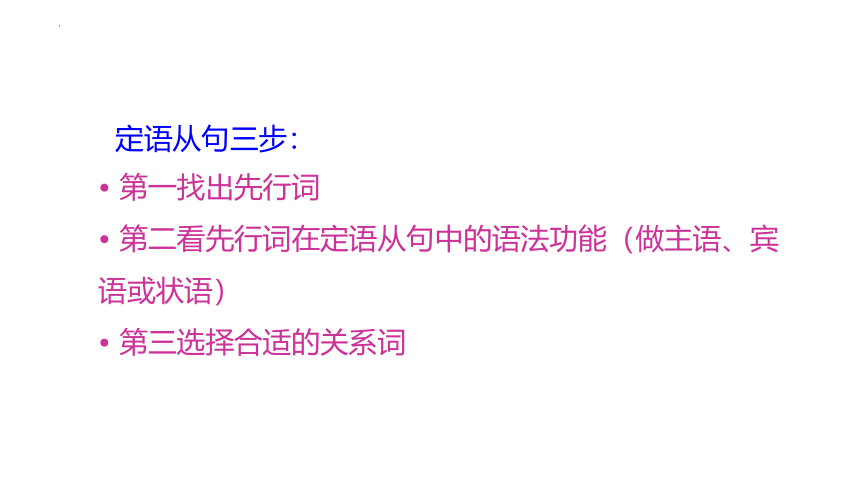
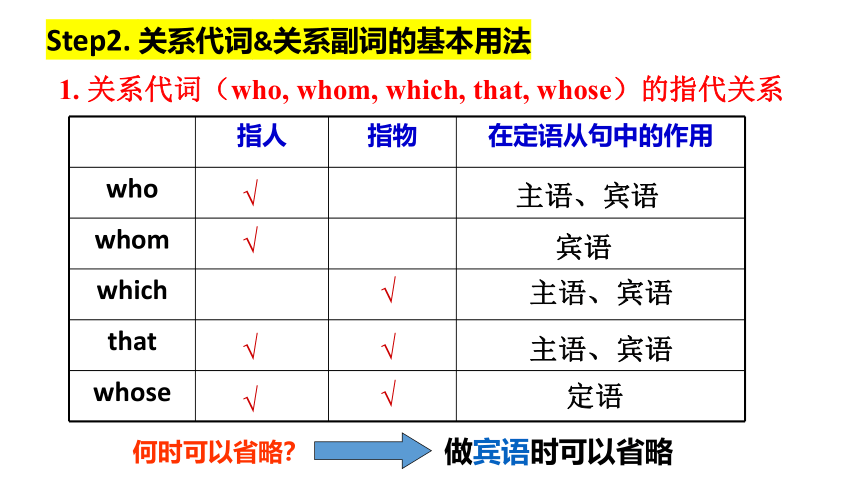
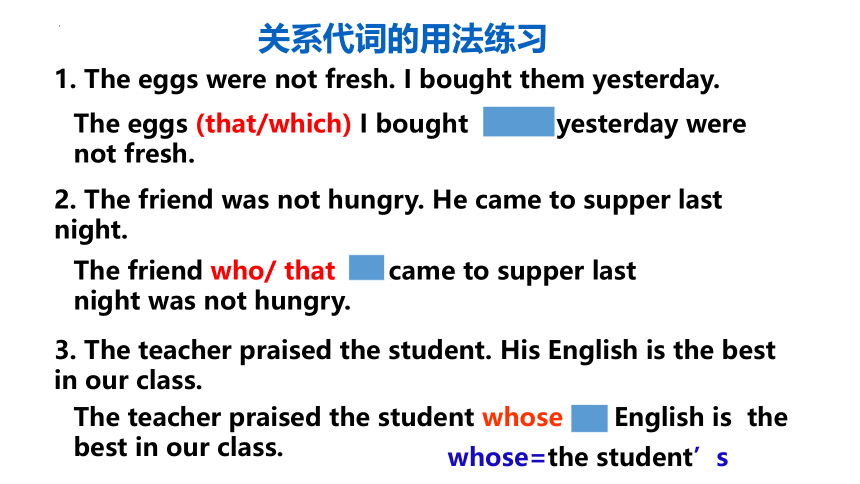
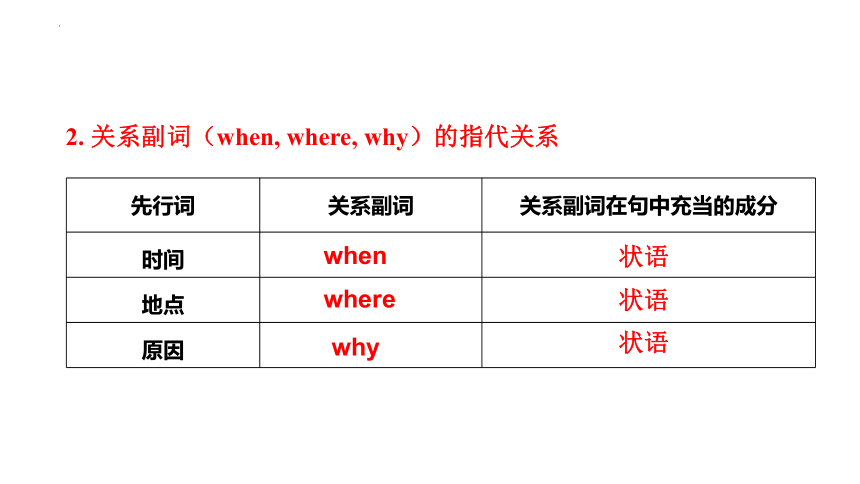
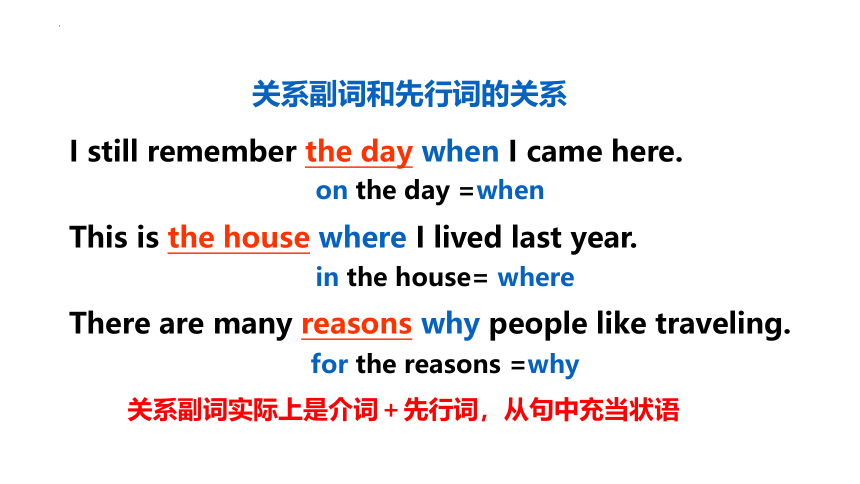
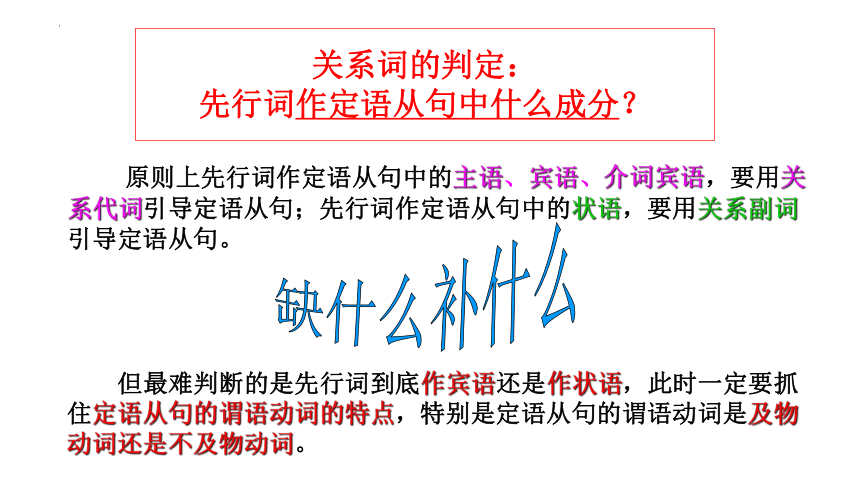
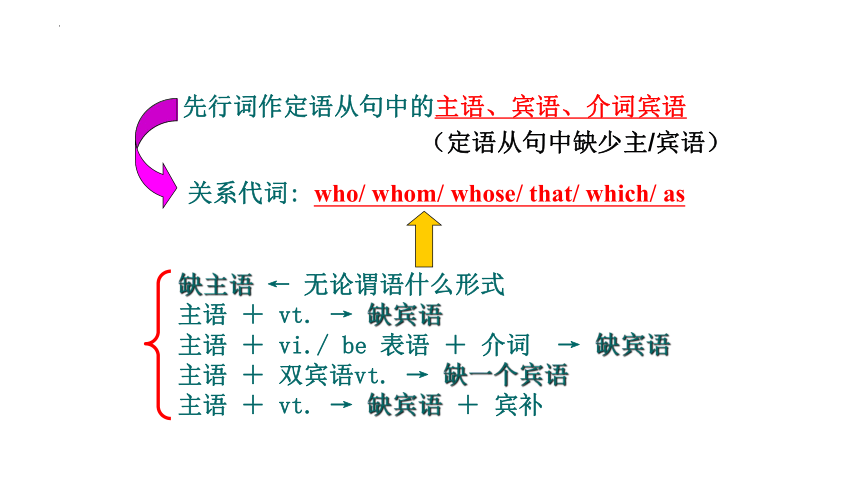
文档简介
(共51张PPT)
定语从句(The Attributive Clause)
定语从句
状语从句
名词性从句
主语从句
宾语从句
表语从句
同位语从句
英语中三大从句类型:
1. 掌握定语从句的概念、结构、几个重点关系代词和关系副词的用法;
2. 能够辨别限制性定语从句与非限制性定语从句;
3. 学会“介词+关系代词“ 引导的定语从句,并会实际操作;
4. 掌握关系代词as的用法;
5. 掌握way做先行词时引导词的用法;
6. 几种容易混淆的句型。
本课要点
1. 定语从句的概念:句子中起定语作用的从句。
2. 定语从句的构成
先行词
主句中被修饰或限定的名词或代词
关系词
关系代词和关系副词,引导定语从句并代替先行词在从句中做相同成分
从句
1、缺少主语/宾语/状语/定语;
2、但必须有谓语;
3、所缺成分具有唯一性;
4、缺什么补什么;
+
+
Step.1 定语从句的概念及结构
引导词即关系代词和关系副词有三大作用:
1. 连接作用
2. 指代作用
3. 担当成分作用
连接定语从句和主句
替代前面的先行词
在定语从句中一定要充当句子成分
He prefers the cheese that / which comes from his parents' farm.
He says that he prefers the cheese from his parents' farm.
宾从,无先行词之说,在这仅起连接作用
定从,引导词做主语
定语从句三步:
第一找出先行词
第二看先行词在定语从句中的语法功能(做主语、宾语或状语)
第三选择合适的关系词
Step2. 关系代词&关系副词的基本用法
1. 关系代词(who, whom, which, that, whose)的指代关系
指人 指物 在定语从句中的作用
who
whom
which
that
whose
√
主语、宾语
√
宾语
√
主语、宾语
√
√
主语、宾语
√
√
定语
何时可以省略?
做宾语时可以省略
关系代词的用法练习
1. The eggs were not fresh. I bought them yesterday.
2. The friend was not hungry. He came to supper last night.
3. The teacher praised the student. His English is the best in our class.
The eggs (that/which) I bought them yesterday were not fresh.
The friend who/ that he came to supper last night was not hungry.
The teacher praised the student whose his English is the best in our class.
whose=the student’s
2. 关系副词(when, where, why)的指代关系
先行词 关系副词 关系副词在句中充当的成分
时间
地点
原因
when
状语
where
状语
why
状语
关系副词和先行词的关系
I still remember the day when I came here.
This is the house where I lived last year.
There are many reasons why people like traveling.
on the day =when
in the house= where
for the reasons =why
关系副词实际上是介词+先行词,从句中充当状语
关系词的判定:
先行词作定语从句中什么成分?
原则上先行词作定语从句中的主语、宾语、介词宾语,要用关系代词引导定语从句;先行词作定语从句中的状语,要用关系副词引导定语从句。
缺什么补什么
但最难判断的是先行词到底作宾语还是作状语,此时一定要抓住定语从句的谓语动词的特点,特别是定语从句的谓语动词是及物动词还是不及物动词。
先行词作定语从句中的主语、宾语、介词宾语
关系代词: who/ whom/ whose/ that/ which/ as
缺主语 ← 无论谓语什么形式
主语 + vt. → 缺宾语
主语 + vi./ be 表语 + 介词 → 缺宾语
主语 + 双宾语vt. → 缺一个宾语
主语 + vt. → 缺宾语 + 宾补
(定语从句中缺少主/宾语)
先行词作定语从句中的状语
关系副词:when/ where/ why(或介词+which)
主语 + vi. → 缺状语
主语 + vt. + 宾语 → 缺状语
主语 + be + 表语 → 缺状语 主语 + be done (被动语态)→ 缺状语
主语 + vt. + 双宾语/ 复合宾语 → 缺状语
(定语从句中缺少状语)
1) I’ll never forget the day _________ we first met in the park.
2) I’ll never forget the time _____________ I spent with you.
3) This is the museum _________ I paid a visit last year.
4) This is the museum ______________ I visited last year.
when
(which/ that)
where
(which/ that)
when, where, why &that, which
主语 + vi. → 缺状语
主语 + vt. → 缺宾语
主语 + vt. + 宾语 → 缺状语
主语 + vt. → 缺宾语
5) This is the story _____________ the old man told us young people.
6) This is the story _______ the old man told us young people his experience.
7) This is the point _______ I don't agree.
8) This is the point _____________ I don't agree with.
(that/ which)
where
where
(which/ that)
主语 + 双宾语vt. → 缺一个宾语
主语 + vt. + 双宾语 → 缺状语
主语 + vi. → 缺状语
主语 + vi. + 介词 → 缺宾语
9) Later, they came to a place _____________ the natives called the Ghost Cave.
10) This is the very case _______ a new word is used uncorrectly, although it has been learnt by heart.
(that/ which)
where
主语 + vt. → 缺宾语 + 宾补
主语 + be done (被动语态)→ 缺状语
* 先行词为表示抽象空间概念的名词,如case, situation, position, stage, point, atmosphere等时,在从句中作状语用关系副词where引导。
容易误用作不及物动词的 及物动词(vt.)
visit, spend, watch, buy, enter, reach, mention(提到), serve, marry, discuss, fit, lack(缺乏), greet(问候), ring, doubt(怀疑), say等
上述及物动词作谓语(后无宾语)时,定语从句要关系代词引导。
That was a cave ___________ nobody had entered before.
(which/ that)
容易误用作及物动词的不及物动词(vi.)
arrive, live, work, stay, agree, disagree, knock, object(反对), lie, flow, operate(做手术), depend, rely(依靠、取决于), wait, happen,
insist(坚持), reply, talk, look, listen, belong, rise, give in等
上述不及物动词作谓语时,定语从句(不缺主语)要用关系副词或介词加关系代词引导。
Lanzhou is a city ___________________ the Yellow River flows.
where/ through which
Step3. 定语从句分类
1. The Restrictive Attributive Clause
限制性定语从句
2. The Non-Restrictive Attributive Clause
非限制性定语从句
限制性定语从句的构成
The old lady who lives next to us sells books.
You should do all that I said.
I have found the artist whom I am looking for .
I visited the factory where my father works.
先行词之后,用陈述句语序
“….的”
关系代词
关系副词
关系词
3.构成
2.翻译方法:
1.从句位置及语序:
非限制性定语从句
The town where I live is beautiful.
Lanshan, where I live, is beautiful.
Teachers who are kind are popular with the students.
Mr Wang, who is kind, is popular with the students.
Please compare:
形式 作用 能否省略 翻译
限制性定语从句
非限制性定语从句
插入成分,有逗号
修饰限定,联系紧密
补充解释
不能
能
….的,先翻译从句,后翻译先行词
无逗号
先译先行词后翻译从句
限制性定从, 省略后主语所指就不明确,去掉句意大受影响。
非限制定从, 起补充作用,去掉,句意不受或少受影响。
非限制性定语从句和单句的比较
1.He failed in the exam._______ made his parents angry.
2.He failed in the exam, ________made his parents angry.
This
which
× that
非限制性定语从句,可以指代前面整个句子,不能用that做引导词
We’ll go to visit the famous school.
We have often talked _____the famous school.
This is the boy.
I played tennis _____the boy yesterday.
We’ll go to visit the famous school which/ that/ \ we have often talked.
Step4.“介词+关系代词”引导的定语从句
关系代词在定语从句中作介词宾语时,从句常常由“介词+关系代词”引出。
with
about
This is the boy whom/ that/ \ / who I played tennis.
with
×
×
×
×
×
about
介词+ which指物
介词+ whom指人
who、that 不能用与介词之后
根据从句中的动词搭配
This is the book _____ which you asked.
注意:动词短语不能拆,即介词不提前
我照顾的那个老人好多了。
The old man after whom I am looking is better.
The old man whom I am looking after is better.
如何判断介词
for
根据从句中的形容词搭配
He told me some reference books ____ which I am not very familiar.
with
根据先行词与介词搭配
I ’ll never forget the day ________ he made the speech.
The month _____which I left for vocation is July.
The moment _____which I made the decision is exciting.
on
in
at
4. 根据定语从句所表达的意义和逻辑来确定。
Air, ________ which man can’t live, is really important.
without
5. whose引导的定语从句表示所属关系时可转换为“ of +关系代词(which/whom)”
They live in a house, the door of which opens to the south.
They live in a house, of which the door opens to the south.
e.g. They live in a house, whose door opens to the south.
* “介词+关系代词”前还可有some, any, none, all, both, neither, many, most, each , few等代词或者数词。
He loves his parents deeply, both of whom are very kind to him.
There are forty students in our class in all, most of whom are from big cities.
Step5. 定语从句几大考点
考点一:从句中动词的数
The recorder that has been given to me is home-made.
1、关系代词作从句的主语时,从句中谓语动的人称和数要与先行词保持一致;先行词是句子时,从句的谓语动词用第三人称单数形式。如:
I, who am your classmate, will share the work with you.
He seems not to have grasped what I meant, which greatly upsets me.
He is one of the students who have made great progress.
2、“one of +复数名词”位于关系代词前作先行词时,从句的动词通常要用复数;当one前有the (only), the (very)等修饰时,从句的谓语动词要用单数。如:
Mr Wang is the only one of my friends who has been invited to have dinner with us.
1.先行词为 everything, little, much, all, anything, nothing, none, few等不定代词, 或被不定代词修饰时
2. 先行词前有形容词最高级、序数词修饰时,或被 the only, the very,the last 修饰时
3.先行词同时指人和指物时
4. 在以which / who 为疑问词的特殊疑问句中
5.在there be (先行词指物做主语)/ here is 开头/ it is time 句型中
以下情况,引导词用that,不用which。
考点二:只用that 不用 which
考点三:只能用which不用that引导的定语从句。
1. 引导非限制性定语从句时, 其先行词可是一个词,也可是整个主句或主句的某一部分。
3.句子中同时有两个定语从句,其中一个已经用了 that 引导时
2. 先行词是物,紧接在介词后面时
考点四:关系代词 as 的用法
☆ the same … as 表示同一类人或物;
the same … that 指同一个人或物
1. 直接引导定语从句: 作用相当于which
He was late, as / which is often the case.
2. 与such 连用, 引导定语从句
There are no such writers as you mention.
It gave him such a shock that his face turned white.
3. 与same 连用, 引起定语从句
如此 …… 以至于
This is the same pen ______I lost yesterday.
A. as B. that
C. the one D. A&B
D
...the same pen as I lost.
... the same pen that I lost.
表示这支笔与我不见的那支很像,不一定就是
则表示这支笔就是我不见的那支
Eg:
比较:
4. as 与 which 的区别
1) 限制性定语从句中
名词前有such和the same修饰时,关系代词用as,不能用which
2)非限制性定语从句中
as和which都可以指代前面整个主句。如果有“正如,像”的含义,并可以放在主句前,也可以放在后面,那么用as;而which引导的从句只能放主句后,并无“正如”的意思
They won the game, as we had expected.
They won the game, which we hadn't expected.
★as 在从句中作主语时,后面常接行为动词的被动语态,如 be known,be said,be reported 等
1. 先行词是人称代词时,如:
He, who just heard the news of his father’s death, burst into tears.
2. those做先行词指人做主语时,关系代词多用who。
He admired those who looked beautiful.
考点五: 什么情况下用 who 不用 that?
考点六 : way做先行词引导的定语从句
填上合适的关系词并分析原因:
1.The way _____________________he explained the sentence to us was not difficult to understand.
2.The way ____________________he explained to us was quite simple.
that/ which/不填
that/in which/不填
缺状语
缺宾语
缺少主语或宾语:
引导词用that / which / 不填(缺宾语时)
主语宾语都不缺:
引导词用that / in which / 不填
Step6. 易混句型
1). a. I saw some trees, and the leaves of_________ were black
with disease.
b. I saw some trees, the leaves of _________ were black with
disease.
2).a. The professor is a little man, on the nose of _______ there
is a pair of glasses.
b. The professor is a little man, and on the nose of ______there
is a pair of glasses
解题点拨 : 是否有连词是区分定语从句和并列句的关键。
1.定语从句与并列句
them
whom
which
him
1). a. The news ________our volleyball team won the match
made us excited.
b. The news ____________he told me yesterday is exciting.
2). a. I made a promise _____ if anyone set me free, I would
make him very rich.
b. The mother made a promise ___________ pleased all
her children.
that
(that/which)
that/which
that
解题点拨:
that引导的定语从句是对其先行词的修饰或限制;在句中作成份(作宾语省略), 指物时可用which代替;
而同位语从句是对前面名词的说明和解释; that在从句中仅起连接作用, 不充当成份,不能省略, 不能用which代替。
2.定语从句与同位语从句
1) a. It is in this room ______I lived last year.
b. It is the room _______I lived last year.
2) a. It was at seven o’clock ______he went to school this
morning.
b. It was seven o’clock _______he went to school this
morning.
强调句型:
It is/was+被强调的成份+that/who+其它部分;
去掉 It is /was….that/who… ,句子照样成立;
而定语从句的引导词在句中要作成份。
that
where
that
when
3.定语从句与强调句
1. 他指给我看他丢钱包的地方。
He showed me the place where he lost his wallet.
2. 我不认识那个和你说话的女孩。
I don’t know the girl whom/that you speak to.
3. 她是一个叫玛丽的女孩。
She is a girl who is called Mary.
4. 那些正在打网球的男孩是我的朋友。
Those boys who are playing tennis are my friends.
5. 你记不记得我们到这儿的那一天
Do you remember the day when we arrived here
高考真题演练
1
2
3
4
5
6
7
8
9
THANK YOU !
定语从句(The Attributive Clause)
定语从句
状语从句
名词性从句
主语从句
宾语从句
表语从句
同位语从句
英语中三大从句类型:
1. 掌握定语从句的概念、结构、几个重点关系代词和关系副词的用法;
2. 能够辨别限制性定语从句与非限制性定语从句;
3. 学会“介词+关系代词“ 引导的定语从句,并会实际操作;
4. 掌握关系代词as的用法;
5. 掌握way做先行词时引导词的用法;
6. 几种容易混淆的句型。
本课要点
1. 定语从句的概念:句子中起定语作用的从句。
2. 定语从句的构成
先行词
主句中被修饰或限定的名词或代词
关系词
关系代词和关系副词,引导定语从句并代替先行词在从句中做相同成分
从句
1、缺少主语/宾语/状语/定语;
2、但必须有谓语;
3、所缺成分具有唯一性;
4、缺什么补什么;
+
+
Step.1 定语从句的概念及结构
引导词即关系代词和关系副词有三大作用:
1. 连接作用
2. 指代作用
3. 担当成分作用
连接定语从句和主句
替代前面的先行词
在定语从句中一定要充当句子成分
He prefers the cheese that / which comes from his parents' farm.
He says that he prefers the cheese from his parents' farm.
宾从,无先行词之说,在这仅起连接作用
定从,引导词做主语
定语从句三步:
第一找出先行词
第二看先行词在定语从句中的语法功能(做主语、宾语或状语)
第三选择合适的关系词
Step2. 关系代词&关系副词的基本用法
1. 关系代词(who, whom, which, that, whose)的指代关系
指人 指物 在定语从句中的作用
who
whom
which
that
whose
√
主语、宾语
√
宾语
√
主语、宾语
√
√
主语、宾语
√
√
定语
何时可以省略?
做宾语时可以省略
关系代词的用法练习
1. The eggs were not fresh. I bought them yesterday.
2. The friend was not hungry. He came to supper last night.
3. The teacher praised the student. His English is the best in our class.
The eggs (that/which) I bought them yesterday were not fresh.
The friend who/ that he came to supper last night was not hungry.
The teacher praised the student whose his English is the best in our class.
whose=the student’s
2. 关系副词(when, where, why)的指代关系
先行词 关系副词 关系副词在句中充当的成分
时间
地点
原因
when
状语
where
状语
why
状语
关系副词和先行词的关系
I still remember the day when I came here.
This is the house where I lived last year.
There are many reasons why people like traveling.
on the day =when
in the house= where
for the reasons =why
关系副词实际上是介词+先行词,从句中充当状语
关系词的判定:
先行词作定语从句中什么成分?
原则上先行词作定语从句中的主语、宾语、介词宾语,要用关系代词引导定语从句;先行词作定语从句中的状语,要用关系副词引导定语从句。
缺什么补什么
但最难判断的是先行词到底作宾语还是作状语,此时一定要抓住定语从句的谓语动词的特点,特别是定语从句的谓语动词是及物动词还是不及物动词。
先行词作定语从句中的主语、宾语、介词宾语
关系代词: who/ whom/ whose/ that/ which/ as
缺主语 ← 无论谓语什么形式
主语 + vt. → 缺宾语
主语 + vi./ be 表语 + 介词 → 缺宾语
主语 + 双宾语vt. → 缺一个宾语
主语 + vt. → 缺宾语 + 宾补
(定语从句中缺少主/宾语)
先行词作定语从句中的状语
关系副词:when/ where/ why(或介词+which)
主语 + vi. → 缺状语
主语 + vt. + 宾语 → 缺状语
主语 + be + 表语 → 缺状语 主语 + be done (被动语态)→ 缺状语
主语 + vt. + 双宾语/ 复合宾语 → 缺状语
(定语从句中缺少状语)
1) I’ll never forget the day _________ we first met in the park.
2) I’ll never forget the time _____________ I spent with you.
3) This is the museum _________ I paid a visit last year.
4) This is the museum ______________ I visited last year.
when
(which/ that)
where
(which/ that)
when, where, why &that, which
主语 + vi. → 缺状语
主语 + vt. → 缺宾语
主语 + vt. + 宾语 → 缺状语
主语 + vt. → 缺宾语
5) This is the story _____________ the old man told us young people.
6) This is the story _______ the old man told us young people his experience.
7) This is the point _______ I don't agree.
8) This is the point _____________ I don't agree with.
(that/ which)
where
where
(which/ that)
主语 + 双宾语vt. → 缺一个宾语
主语 + vt. + 双宾语 → 缺状语
主语 + vi. → 缺状语
主语 + vi. + 介词 → 缺宾语
9) Later, they came to a place _____________ the natives called the Ghost Cave.
10) This is the very case _______ a new word is used uncorrectly, although it has been learnt by heart.
(that/ which)
where
主语 + vt. → 缺宾语 + 宾补
主语 + be done (被动语态)→ 缺状语
* 先行词为表示抽象空间概念的名词,如case, situation, position, stage, point, atmosphere等时,在从句中作状语用关系副词where引导。
容易误用作不及物动词的 及物动词(vt.)
visit, spend, watch, buy, enter, reach, mention(提到), serve, marry, discuss, fit, lack(缺乏), greet(问候), ring, doubt(怀疑), say等
上述及物动词作谓语(后无宾语)时,定语从句要关系代词引导。
That was a cave ___________ nobody had entered before.
(which/ that)
容易误用作及物动词的不及物动词(vi.)
arrive, live, work, stay, agree, disagree, knock, object(反对), lie, flow, operate(做手术), depend, rely(依靠、取决于), wait, happen,
insist(坚持), reply, talk, look, listen, belong, rise, give in等
上述不及物动词作谓语时,定语从句(不缺主语)要用关系副词或介词加关系代词引导。
Lanzhou is a city ___________________ the Yellow River flows.
where/ through which
Step3. 定语从句分类
1. The Restrictive Attributive Clause
限制性定语从句
2. The Non-Restrictive Attributive Clause
非限制性定语从句
限制性定语从句的构成
The old lady who lives next to us sells books.
You should do all that I said.
I have found the artist whom I am looking for .
I visited the factory where my father works.
先行词之后,用陈述句语序
“….的”
关系代词
关系副词
关系词
3.构成
2.翻译方法:
1.从句位置及语序:
非限制性定语从句
The town where I live is beautiful.
Lanshan, where I live, is beautiful.
Teachers who are kind are popular with the students.
Mr Wang, who is kind, is popular with the students.
Please compare:
形式 作用 能否省略 翻译
限制性定语从句
非限制性定语从句
插入成分,有逗号
修饰限定,联系紧密
补充解释
不能
能
….的,先翻译从句,后翻译先行词
无逗号
先译先行词后翻译从句
限制性定从, 省略后主语所指就不明确,去掉句意大受影响。
非限制定从, 起补充作用,去掉,句意不受或少受影响。
非限制性定语从句和单句的比较
1.He failed in the exam._______ made his parents angry.
2.He failed in the exam, ________made his parents angry.
This
which
× that
非限制性定语从句,可以指代前面整个句子,不能用that做引导词
We’ll go to visit the famous school.
We have often talked _____the famous school.
This is the boy.
I played tennis _____the boy yesterday.
We’ll go to visit the famous school which/ that/ \ we have often talked.
Step4.“介词+关系代词”引导的定语从句
关系代词在定语从句中作介词宾语时,从句常常由“介词+关系代词”引出。
with
about
This is the boy whom/ that/ \ / who I played tennis.
with
×
×
×
×
×
about
介词+ which指物
介词+ whom指人
who、that 不能用与介词之后
根据从句中的动词搭配
This is the book _____ which you asked.
注意:动词短语不能拆,即介词不提前
我照顾的那个老人好多了。
The old man after whom I am looking is better.
The old man whom I am looking after is better.
如何判断介词
for
根据从句中的形容词搭配
He told me some reference books ____ which I am not very familiar.
with
根据先行词与介词搭配
I ’ll never forget the day ________ he made the speech.
The month _____which I left for vocation is July.
The moment _____which I made the decision is exciting.
on
in
at
4. 根据定语从句所表达的意义和逻辑来确定。
Air, ________ which man can’t live, is really important.
without
5. whose引导的定语从句表示所属关系时可转换为“ of +关系代词(which/whom)”
They live in a house, the door of which opens to the south.
They live in a house, of which the door opens to the south.
e.g. They live in a house, whose door opens to the south.
* “介词+关系代词”前还可有some, any, none, all, both, neither, many, most, each , few等代词或者数词。
He loves his parents deeply, both of whom are very kind to him.
There are forty students in our class in all, most of whom are from big cities.
Step5. 定语从句几大考点
考点一:从句中动词的数
The recorder that has been given to me is home-made.
1、关系代词作从句的主语时,从句中谓语动的人称和数要与先行词保持一致;先行词是句子时,从句的谓语动词用第三人称单数形式。如:
I, who am your classmate, will share the work with you.
He seems not to have grasped what I meant, which greatly upsets me.
He is one of the students who have made great progress.
2、“one of +复数名词”位于关系代词前作先行词时,从句的动词通常要用复数;当one前有the (only), the (very)等修饰时,从句的谓语动词要用单数。如:
Mr Wang is the only one of my friends who has been invited to have dinner with us.
1.先行词为 everything, little, much, all, anything, nothing, none, few等不定代词, 或被不定代词修饰时
2. 先行词前有形容词最高级、序数词修饰时,或被 the only, the very,the last 修饰时
3.先行词同时指人和指物时
4. 在以which / who 为疑问词的特殊疑问句中
5.在there be (先行词指物做主语)/ here is 开头/ it is time 句型中
以下情况,引导词用that,不用which。
考点二:只用that 不用 which
考点三:只能用which不用that引导的定语从句。
1. 引导非限制性定语从句时, 其先行词可是一个词,也可是整个主句或主句的某一部分。
3.句子中同时有两个定语从句,其中一个已经用了 that 引导时
2. 先行词是物,紧接在介词后面时
考点四:关系代词 as 的用法
☆ the same … as 表示同一类人或物;
the same … that 指同一个人或物
1. 直接引导定语从句: 作用相当于which
He was late, as / which is often the case.
2. 与such 连用, 引导定语从句
There are no such writers as you mention.
It gave him such a shock that his face turned white.
3. 与same 连用, 引起定语从句
如此 …… 以至于
This is the same pen ______I lost yesterday.
A. as B. that
C. the one D. A&B
D
...the same pen as I lost.
... the same pen that I lost.
表示这支笔与我不见的那支很像,不一定就是
则表示这支笔就是我不见的那支
Eg:
比较:
4. as 与 which 的区别
1) 限制性定语从句中
名词前有such和the same修饰时,关系代词用as,不能用which
2)非限制性定语从句中
as和which都可以指代前面整个主句。如果有“正如,像”的含义,并可以放在主句前,也可以放在后面,那么用as;而which引导的从句只能放主句后,并无“正如”的意思
They won the game, as we had expected.
They won the game, which we hadn't expected.
★as 在从句中作主语时,后面常接行为动词的被动语态,如 be known,be said,be reported 等
1. 先行词是人称代词时,如:
He, who just heard the news of his father’s death, burst into tears.
2. those做先行词指人做主语时,关系代词多用who。
He admired those who looked beautiful.
考点五: 什么情况下用 who 不用 that?
考点六 : way做先行词引导的定语从句
填上合适的关系词并分析原因:
1.The way _____________________he explained the sentence to us was not difficult to understand.
2.The way ____________________he explained to us was quite simple.
that/ which/不填
that/in which/不填
缺状语
缺宾语
缺少主语或宾语:
引导词用that / which / 不填(缺宾语时)
主语宾语都不缺:
引导词用that / in which / 不填
Step6. 易混句型
1). a. I saw some trees, and the leaves of_________ were black
with disease.
b. I saw some trees, the leaves of _________ were black with
disease.
2).a. The professor is a little man, on the nose of _______ there
is a pair of glasses.
b. The professor is a little man, and on the nose of ______there
is a pair of glasses
解题点拨 : 是否有连词是区分定语从句和并列句的关键。
1.定语从句与并列句
them
whom
which
him
1). a. The news ________our volleyball team won the match
made us excited.
b. The news ____________he told me yesterday is exciting.
2). a. I made a promise _____ if anyone set me free, I would
make him very rich.
b. The mother made a promise ___________ pleased all
her children.
that
(that/which)
that/which
that
解题点拨:
that引导的定语从句是对其先行词的修饰或限制;在句中作成份(作宾语省略), 指物时可用which代替;
而同位语从句是对前面名词的说明和解释; that在从句中仅起连接作用, 不充当成份,不能省略, 不能用which代替。
2.定语从句与同位语从句
1) a. It is in this room ______I lived last year.
b. It is the room _______I lived last year.
2) a. It was at seven o’clock ______he went to school this
morning.
b. It was seven o’clock _______he went to school this
morning.
强调句型:
It is/was+被强调的成份+that/who+其它部分;
去掉 It is /was….that/who… ,句子照样成立;
而定语从句的引导词在句中要作成份。
that
where
that
when
3.定语从句与强调句
1. 他指给我看他丢钱包的地方。
He showed me the place where he lost his wallet.
2. 我不认识那个和你说话的女孩。
I don’t know the girl whom/that you speak to.
3. 她是一个叫玛丽的女孩。
She is a girl who is called Mary.
4. 那些正在打网球的男孩是我的朋友。
Those boys who are playing tennis are my friends.
5. 你记不记得我们到这儿的那一天
Do you remember the day when we arrived here
高考真题演练
1
2
3
4
5
6
7
8
9
THANK YOU !
